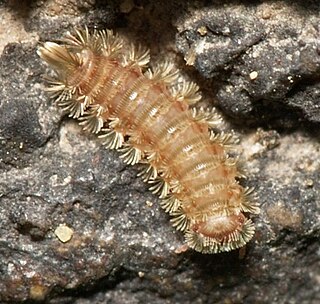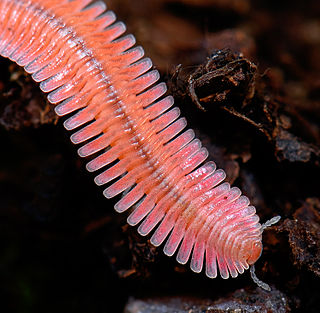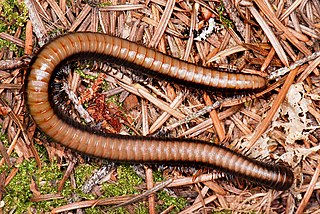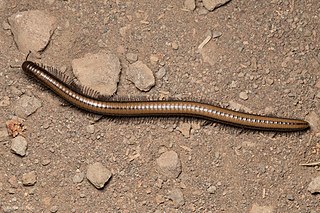
Glomerida is an order of pill-millipedes found primarily in the Northern Hemisphere. Also known as northern pill millipedes, they superficially resemble pill-bugs or woodlice, and can enroll into a protective ball. They have twelve body segments, 17 to 19 pairs of legs, and males have enlarged rear legs involved in mating. The order includes about 30 genera and at least 280 species, including Glomeris marginata, the common European pill-millipede. The order contains members in Europe, South-east Asia and the Americas from California to Guatemala. Although historically considered closely related with the similar sphaerotheriidans that also enroll, some DNA evidence suggest they may be more closely related to glomeridesmidans, a poorly known order that does not enroll.

Polydesmida is the largest order of millipedes, with more than 5,000 species, including all the millipedes reported to produce hydrogen cyanide (HCN). This order is also the most diverse of the millipede orders in terms of morphology. Millipedes in this order are found in all regions of the world other than Antarctica.

Xystodesmidae is a family of millipedes in the suborder Leptodesmidea within the order Polydesmida. The family Xystodesmidae was created by the American biologist Orator F. Cook in 1895 and named after the genus Xystodesmus. This family includes more than 390 known species distributed among 62 genera. Many species, however, remain undescribed: for example, it is estimated that the genus Nannaria contains over 200 species, but only 25 were described as of 2006. By 2022, 78 species in Nannaria have been described.

Polyxenida is an order of millipedes readily distinguished by a unique body plan consisting of a soft, non-calcified body ornamented with tufts of bristles. These features have inspired the common names bristly millipedes or pincushion millipedes. This order includes about 148 species in four families worldwide, which represent the only living members of the subclass Penicillata.

Glomeridesmida is an order of millipedes in the infraclass Pentazonia containing two families and at least 35 described species. Glomeridesmida is the only living order of the superorder Limacomorpha. Glomeridesmidans are also known as slug millipedes.

Platydesmida is an order of millipedes containing two families and over 60 species. Some species practice paternal care, in which males guard the eggs.
Aprosphylosoma darceneae is a species of cylindrical julidan millipede found only in the U.S. state of Oregon and comprising the sole species of the family Aprosphylosomatidae. It is known from only a single known specimen collected from Oregon Caves National Monument in 1956 that measures approximately 16 mm (0.63 in) long and 1 mm wide, possessing 59 body segments. The first pair of legs are extremely reduced into non-jointed, peg-like structures. The body color is yellowish brown with darker brown mottling on the dorsal surface, and the legs are white.

Paeromopodidae is a family of large cylindrical millipedes of the order Julida native to the western United States of America. The family contains two genera and ten species and includes the longest millipedes in North America, with individuals reaching up to 16.5 cm (6.5 in) long.

Paeromopus is a genus of large cylindrical millipedes endemic to the U.S. state of California. All species exceed 10 centimeters in length, and the largest, P. paniculus, reaching 16.5 cm is the longest millipede species in North America. The genus was named by German entomologist Ferdinand Karsch in 1881 and contains four species: three occupying small ranges in the Sierra Nevada mountains and one occupying a large range including the Sierra Nevada and much of Northern California to the Central Coast.
Paeromopus paniculus is a species of millipede endemic to the Sierra Nevada mountains in the United States state of California. Reaching up to 16.5 centimeters in length, it is the longest known millipede in North America.

Californiulus is a genus of cylindrical millipedes containing six species native to the western United States.

Californiulus yosemitensis is a species of cylindrical millipede in the family Paeromopodidae that is found in western North America: predominantly in the Sierra Nevada of California but also extending into southeastern Oregon and parts of Nevada.

Boreohesperus is a genus of paradoxosomatid millipedes containing six species native to Western Australia. The name refers to the northwestern distribution in Australia, deriving from Boreas, Greek god of the North, and hesperus, Latin for "west".

Selenocheir sinuata is a species of flat-backed millipede in the family Xystodesmidae, endemic to Northern California. The Species was first described by Rowland M. Shelley in 1994 based on samples collected by J. S. Buckett and M. R. Gardner in 1966

Tubaphe is a genus of millipede in the family Xystodesmidae with a single described species, Tubaphe levii. The genus was erected by Nell B. Causey in 1954.

Chonaphe armata is a species of Xystodesmid millipede found in the Pacific Northwest of North America. The species was first described as Polydesmus armatus by O. Harger in 1872 and was later moved to the new genus Chonaphe, for which it is the type species, by O. F. Cook in 1904.

Selenocheir arcuata is a species of Xystodesmid millipede found in Northern California. The species was first described by Rowland M. Shelley in 1994 based on samples collected by C. Smith, J. Clover, and F. Ennik in 1972.

Sigmocheir is a genus of millipede in family Xystodesmidae. The species of this genus are endemic to California where they are found in foothills of the Sierra Nevada mountains. Individuals of the genus can be found from Placer County, south to the northern portion of Tulare County.

Sigmocheir furcata is a species of millipede in the family Xystodesmidae. The species in endemic to California and found in the foothills of the Sierra Nevada mountains.

Sigmocheir calaveras is a species of millipede in the family Xystodesmidae. The species in endemic to California and found in the foothills of the Sierra Nevada mountains.















